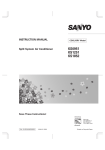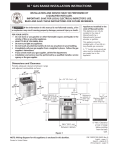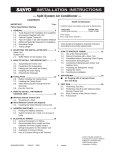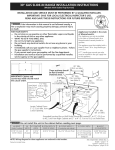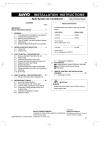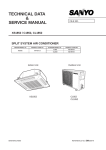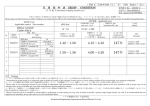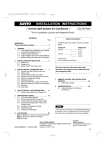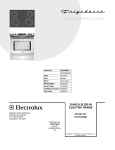Download Sanyo C0951 User's Manual
Transcript
01-384 AirCon 12/11/01 4:35 PM Page 1 INSTALLATION INSTRUCTIONS – Split System Air Conditioner – Contents Model Combinations Page Combine indoor and outdoor units only as listed below. IMPORTANT! Please Read Before Starting .................................. 2 1. 2. 3. GENERAL .......................................................... 3 1-1. Tools Required for Installation (not supplied) 1-2. Accessories Supplied with Unit 1-3. Optional Copper Tubing Kit 1-4. Type of Copper Tube and Insulation Material 1-5. Field Wiring 1-6. Additional Materials Required for Installation 4. HOW TO INSTALL THE OUTDOOR UNIT ....... 15 4-1. Wiring Instructions for the Outdoor Unit 5. REFRIGERANT TUBING .................................. 16 5-1. Use of the Flaring Method 5-2. Flaring Procedure with a Flare Tool 5-3. Caution before Connecting Tubes Tightly 5-4. Connecting Tubing between Indoor and Outdoor Units 5-5. Insulation of Refrigerant Tubing 5-6. Taping the Tubes Indoor Units Outdoor Units KS0951 C0951 CL0951 KS1251 C1251 CL1251 Power Source: 60 Hz, single-phase, 115 V INSTALLATION SITE SELECTION ................... 4 2-1. Indoor Unit 2-2. Outdoor Unit 2-3. Baffle Plate for the Outdoor Unit HOW TO INSTALL THE INDOOR UNIT ............ 6 3-1. Remove the Rear Panel from the Unit 3-2. Make a Hole 3-3. Install the Rear Panel on the Wall 3-4. Remove the Grille to Install the Indoor Unit 3-5. Shape the Indoor Side Tubing 3-6. Wiring Instructions 3-7. Recommended Wire Length and Diameter 3-8. Wiring Instructions for Inter-unit Connections 3-9. Mounting 3-10. Drain Hose COOL /DRY Model KS1852 C1852 CL1852 Power Source: 60 Hz, single-phase, 230/208 V 5-7. Finishing the Installation 6. AIR PURGING................................................... 18 ■ Air Purging with a Vacuum Pump (for Test Run) ■ Basic Function of the Service Valves ■ Pump Down 7. REMOTE CONTROL UNIT INSTALLATION POSITION ......................................................... 22 7-1. Mounting on a Wall IMPORTANT Power source for C0951, CL0951, C1251 and CL1251 is 60 Hz, single-phase 115V. In Canada SANYO FISHER COMPANY 85264189593004 © SANYO 2002 SANYO Canada Inc. A DIVISION OF SANYO NORTH AMERICA CORPORATION 300 Applewood Crescent, Concord 21605 Plummer Street Ontario, L4K 5C7, Canada Chatsworth, CA 91311 U.S.A. W 01-384 AirCon 12/11/01 4:35 PM Page 2 IMPORTANT! Please Read Before Starting When Transporting This air conditioning system meets strict safety and operating standards. As the installer or service person, it is an important part of your job to install or service the system so it operates safely and efficiently. Be careful when picking up and moving the indoor and outdoor units. Get a partner to help, and bend your knees when lifting to reduce strain on your back. Sharp edges or thin aluminum fins on the air conditioner can cut your fingers. For safe installation and trouble-free operation, you must: When Installing… ● Carefully read this instruction booklet before beginning. ● Follow each installation or repair step exactly as shown. …In a Ceiling or Wall ● Observe all local, state, and national electrical codes. Make sure the ceiling/wall is strong enough to hold the ● Pay close attention to all warning and caution notices unit’s weight. It may be necessary to construct a strong wood or metal frame to provide added support. given in this manual. WARNING CAUTION This symbol refers to a hazard or unsafe practice which can result in severe personal injury or death. …In a Room Properly insulate any tubing run inside a room to prevent “sweating” that can cause dripping and water damage to walls and floors. This symbol refers to a hazard or unsafe practice which can result in personal injury or product or property damage. …In Moist or Uneven Locations Use a raised concrete pad or concrete blocks to provide a solid, level foundation for the outdoor unit. This prevents If Necessary, Get Help water damage and abnormal vibration. These instructions are all you need for most installation sites and maintenance conditions. If you require help for a special problem, contact our sales/service outlet or your certified dealer for additional instructions. …In an Area with High Winds Securely anchor the outdoor unit down with bolts and a metal frame. Provide a suitable air baffle. …In a Snowy Area (for Heat Pump-type Systems) In Case of Improper Installation Install the outdoor unit on a raised platform that is higher The manufacturer shall in no way be responsible for improper installation or maintenance service, including failure to follow the instructions in this document. than drifting snow. Provide snow vents. SPECIAL PRECAUTIONS • Use the flare method for connecting tubing. When Connecting Refrigerant Tubing • Apply refrigerant lubricant to the matching surfaces of the WARNING flare and union tubes before connecting them, then tighten When Wiring the nut with a torque wrench for a leak-free connection. ELECTRICAL SHOCK CAN CAUSE SEVERE PERSONAL INJURY OR DEATH. ONLY A QUALIFIED, EXPERIENCED ELECTRICIAN SHOULD ATTEMPT TO WIRE THIS SYSTEM. • Check carefully for leaks before starting the test run. When Servicing • Do not supply power to the unit until all wiring and tubing are completed or reconnected and checked. • Turn the power OFF at the main power box (mains) before opening the unit to check or repair electrical parts • Highly dangerous electrical voltages are used in this system. Carefully refer to the wiring diagram and these instructions when wiring. Improper connections and inadequate grounding can cause accidental injury or death. and wiring. • Keep your fingers and clothing away from any moving parts. • Clean up the site after you finish, remembering to check • Ground the unit following local electrical codes. that no metal scraps or bits of wiring have been left inside • Connect all wiring tightly. Loose wiring may cause overheating at connection points and a possible fire hazard. the unit being serviced. 2 01-384 AirCon 12/11/01 4:35 PM Page 3 1. General This booklet briefly outlines where and how to install the air conditioning system. Please read over the entire set of instructions for the indoor and outdoor units and make sure all accessory parts listed are with the system before beginning. 5. 6. 7. 8. 9. 10. 11. 12. 13. 14. 15. 1-1. Tools Required for Installation (not supplied) 1. Standard screwdriver 2. Phillips head screwdriver 3. Knife or wire stripper 4. Tape measure Carpenter’s level Sabre saw or key hole saw Hacksaw Core bits Hammer Drill Tube cutter Tube flaring tool Torque wrench Adjustable wrench Reamer (for deburring) 1-2. Accessories Supplied with Unit Table 1 Parts Figure Q’ty Parts Rawl plug 12 Tapping screw Drain hose adapter 1 Remote control holder Hex wrench* 1 Parts Q’ty Q’ty 12 Remote control unit 1 1 AAA alkaline battery 2 * Packed in the outdoor unit. 1-3. Optional Copper Tubing Kit 2. Copper tubing for connecting the outdoor unit to the indoor unit is available in kits which contain the narrow and wide tubing, fittings and insulation. Consult your nearest sales outlet or A/C workshop. 1-5. Field Wiring 1-4. Type of Copper Tube and Insulation Material Foamed polyethylene insulation for the specified O.D. copper tubes as required to precise length of tubing. Wall thickness of the insulation should be not less than 0.3 in. (8 mm). Use insulated copper wire for field wiring. Wire size varies with the total length of wiring. Refer to 3-6. Wiring Instructions for details. If you wish to purchase these materials separately from a local source, you will need: 1. Figure Figure Truss-head Phillips 5/32 × 5/8" (4 × 16 mm) Deoxidized annealed copper tube for refrigerant tubing as detailed in Table 2. CAUTION When cutting tubing, add approximately 12” to 16” (30 cm to 40 cm) to each tube length to reduce vibration between the air conditioning units. Table 2 Narrow Tube Wide Tube Model Outer Dia. Thickness Outer Dia. Thickness 6.35 mm (1/4") 0.8 mm (0.0314") 9.52 mm (3/8") 0.8 mm (0.0314") C0951, CL0951 6.35 mm (1/4") 0.8 mm (0.0314") 12.7 mm (1/2") 0.8 mm (0.0314") C1251, CL1251 6.35 mm (1/4") 0.8 mm (0.0314") 15.88 mm (5/8") 1.0 mm (0.0394") C1852, CL1852 3 Check local electrical codes and regulations before obtaining wire. Also, check any specified instructions or limitations. 01-384 AirCon 12/11/01 4:35 PM Page 4 1-6. Additional Materials Required for Installation 1. 2. Indoor unit Refrigeration (armored) tape Insulated staples or clamps for connecting wire (See local codes) Putty Refrigeration lubricant Clamps or saddles to secure refrigerant tubing 3. 4. 5. Drain hose 2. Installation Site Selection Outside drainage 2-1. Indoor Unit WARNING Fig. 1 To prevent abnormal heat generation and the possibility of fire, do not place obstacles, enclosures and grilles in front of or surrounding the air conditioner in a way that may block air flow. 2" (5 cm) min. *6" (15 cm) min. 2" (5 cm) min. *6" (15 cm) min. 2" (5 cm) min. *6" (15 cm) min. Front View *KS1852 only AVOID: Fig. 2 ● direct sunlight. ● nearby heat sources that may affect performance of the unit. ● areas where leakage of flammable gas may be expected. ● places where large amount of oil mist exist. Tubing length (L) INDOOR UNIT Elevation difference (H) OUTDOOR UNIT DO: ● select an appropriate position from which every corner of the room can be uniformly cooled. (High on a wall is best.) ● select a location that will hold the weight of the unit. ● select a location where tubing and drain hose have the shortest run to the outside. (Fig. 1) Fig. 3a CAUTION ● allow room for operation and maintenance as well as unrestricted air flow around the unit. (Fig. 2) ● install the unit within the maximum elevation difference (H) above the outdoor unit and within a total tubing length (L) from the outdoor unit as detailed in Table 3 and Fig. 3a. Indoor unit For stable operation of the air conditioner, do not install wall-mounted type indoor units under 5 ft. (1.5 m) from floor level. Minimum height from floor level 5 ft. (1.5 m) Floor level Fig. 3b Table 3 Max. Allowable Tubing Length at Shipment (ft.) Limit of Tubing Length (L) (ft.) Limit of Elevation Difference (H) (ft.) Required Amount of Additional Refrigerant (oz./ft.)* Model 25 50 23 a) 0.16 9,000 BTU 25 65 23 b) 0.27 12,000/18,000 BTU * If total tubing length becomes a) 25 to 50 ft. (max.), b) 25 to 65 ft. (max.) charge additional refrigerant (R22) by a) 0.16 oz./ft., b) 0.27 oz./ft. No additional compressor oil is necessary. 4 Wall 01-384 AirCon 12/11/01 4:35 PM Page 5 2-2. Outdoor Unit NO AVOID: ● heat sources, exhaust fans, etc. (Fig. 4) ● damp, humid or uneven locations. Exhaust fan Hot air Heat source DO: Outdoor unit ● choose a place as cool as possible. ● choose a place that is well ventilated. ● allow enough room around the unit for air intake/ exhaust and possible maintenance. (Fig. 5a) Fig. 4 Obstacle above CAUTION ● Do not place objects on or sit on the outdoor unit. Also, never block the air intake/outlet or exhaust. Distortion of the outdoor unit or incomplete combustion may result. ● ● ● Min. 6" Air discharge (15 cm) Valve side Min. 10" (25 cm) Min. Min. 7 ft. 7 ft. (2 m) (2 m) Obstacle Install the outdoor unit above snowfall line. Min. 12" (30 cm) Ground Do not introduce foreign matter into the air intake/outlet or exhaust. Do not poke them with such objects as a stick. Min. 6 in. (15 cm) Air intake Fig. 5a Anchor bolts (4 pcs) provide a solid base (level concrete pad, concrete block, 4 in. × 16 in. (10 × 40 cm) beams or equal), a minimum of 4 in. (10 cm) above ground level to reduce humidity and protect the unit against possible water damage and decreased service life (Fig. 5b). Min. 4" (10 cm) Air intake Concrete or equal use lug bolts or equal to bolt down unit, reducing vibration and noise. 2-3. Baffle Plate for the Outdoor Unit (CL×× models only) Ab ou t1 6" t 4" Abou (40 m) (10 c cm ) NOTE Fig. 5b It is recommended to use baffle plates for models CL1251, CL1852 and CL0951. The baffle plates are not normally required for the other models. 6" min Baffle plate 6" min When the outdoor unit is installed in a position exposed to strong wind (like seasonal winds with low air temperature in winter), baffle plates must be installed in front of the outdoor unit. (Fig. 5c) Air discharge ● Min. 6" (15 cm) Air discharge Air intake This unit is designed so that the fan of the outdoor unit runs at low speed when the air conditioner is operated at low outdoor air temperatures. When the outdoor unit is exposed to strong wind, the system pressure drops because of the freeze protector. Air discharge Fig. 5c 5 Baffle plate 01-384 AirCon 12/11/01 4:35 PM Page 6 3. How to Install the Indoor Unit 3-1. Remove the Rear Panel from the Unit (1) Remove and discard the set screw on the rear panel. (Fig. 6) (2) Press the 2 ▲ marks on the frame cover and disengage the stationary tabs from the frame. (Fig. 7) (3) Remove the rear panel. NOTE Set screw only for transportation Fig. 6 Tubing can be extended in 5 directions (KS0951, KS1251 and KS1852) as shown in Fig. 8a or 8b. Select the direction you need providing the shortest run to the outside unit. Rear panel 3-2. Make a Hole (1) Place the rear panel from the indoor unit on the wall at the location selected. Make sure the panel is horizontal, using a carpenter’s level or tape measure to measure down from the ceiling. Wait until after cutting the hole before attaching the rear panel to the wall. (2) Determine which side of the unit you should make the hole for tubing and wiring. (Fig. 9) (3) Before making the hole, check carefully that no studs or pipes are directly run behind the spot to be cut. Fig. 7 ▲ marks KS0951, KS1251 Right-rear tubing (recommended) Left tubing CAUTION Left-rear tubing Right tubing Fig. 8a ● Also avoid areas where electrical wiring or conduits are located. Downward tubing KS1852 ● Switching drain hose and drain cap Left tubing (a) Locate the drain hose and the drain cap. (Fig. 8c) Right-rear tubing (recommended) (b) Remove the drain hose on the right side by pushing and turning the hose connector counter-clockwise to release it. (Fig. 8c) (c) Apply moderate force to pull off the drain cap on the left side. (If you cannot pull it off by hand, use a long-nose pliers.) Right tubing Fig. 8b Downward tubing (d) Reattach the drain hose to the left side and the drain cap to the right side. (Fig. 8c) The above precautions are also applicable if tubing goes through the wall in any other location. Drain hose In case of right-rear Clamp To slip on Drain cap Fig. 9 Fig. 8c 6 60° To remove 01-384 AirCon 12/11/01 4:35 PM Page 7 (4) Using a sabre saw, key hole saw or hole-cutting drill attachment, cut a hole in the wall. See Table 4 and Fig. 10. NOTE Hole should be made at a slight downward slant to the outdoor side. Table 4 Indoor side Hole Dia. Outdoor side 2-9/16" (65 mm) / 3-5/32" (80 mm) (5) Measure the thickness of the wall from the inside edge to the outside edge and cut PVC pipe at a slight angle 0.25 in. (6 mm) shorter than the thickness of the wall. (Fig. 11) Fig. 10 PVC pipe (locally purchased) (6) Place the plastic cover (locally purchased) over the end of the pipe (for indoor side only) and insert the pipe in the wall. (Fig. 12) 3-3. Install the Rear Panel on the Wall Cut at slight angle Be sure to confirm that the wall is strong enough to suspend the unit. Fig. 11 INSIDE See either Item a) or b) below depending on the wall type. OUTSIDE Wall Plastic cover a) If Wooden Wall PVC pipe Slight angle (1) Attach the rear panel to the wall with the 10 screws provided. (Fig. 13) If you are not able to line up the holes in the rear panel with the beam locations marked on the wall, use rawl plugs or toggle bolts to go through the holes on the panel or drill 3/16 in. (5 mm) dia. holes in the panel over the stud locations and then mount the rear panel. Fig. 12 (2) Double check with a ruler or carpenter’s level that the panel is level. This is important to install the unit properly. (Fig. 14) Fig. 13 (3) Make sure the panel is flush against the wall. Any space between the wall and unit will cause noise and vibration. b) If Block, Brick, Concrete or Similar Type Wall ; ; ; Fig. 14 Make 3/16 in. (4.8 mm) dia. holes in the wall. Insert rawl plugs for appropriate mounting screws. (Fig. 15) 3/16" (4.8 mm) dia. hole Rawl plug Fig. 15 7 01-384 AirCon 12/11/01 4:35 PM Page 8 3-4. Remove the Grille to Install the Indoor Unit KS0951, KS1251 Basically, these models can be installed and wired without removing the grille. If access to any internal part is needed, follow the steps as given below: How to remove the grille (1) Set the flap in the horizontal position. Screw cover Flap (Up and down air direction louvre) (2) Unscrew the screws. (Fig. 16a or 16b) (3) Remove the grille. (Fig. 17) Fig. 16a (a) Hold both corners of the air intake grille, then pull out and up to open. KS1852 (b) Pull the lower part of the grille toward you to remove. (c) Use a standard screwdriver to push up the 3 tabs to remove the grille. How to replace the grille (1) Close the flaps. Fig. 16b (2) Reinstall the grille into the lower part while aligning its tabs on the upper part. (Fig. 18) Insert the tabs in the slots and push the lower part of the grille back into position. Air intake grille (3) Press at each of the 4 tabs to completely close the grille. Make sure that the grille and frame are firmly fitted together. (Fig. 19) Fig. 17 Fig. 18 Fig. 19 8 01-384 AirCon 12/11/01 4:35 PM Page 9 3-5. Shape the Indoor Side Tubing 1) Arrangement of tubing by directions Frame a) Right or left tubing Cut out the corner of the right/left frame with a hacksaw or the like. (Figs. 20 and 21) Left tubing outlet b) Right-rear or left-rear tubing In this case, the corner of the frame need not be cut. 2) To mount the indoor unit on the rear panel: Fig. 20 Hang the 2 mounting slots of the unit on the upper tabs of the rear panel. (Fig. 22) Frame 3-6. Wiring Instructions General precautions on wiring 1) Before wiring, confirm the rated voltage of the unit as shown on its nameplate, then carry out the wiring closely following the wiring diagram. 2) Provide a power outlet to be used exclusively for each unit, with a power supply disconnect and circuit breaker for overcurrent protection provided in the exclusive line. 3) To prevent possible hazard due to insulation failure, the unit must be grounded. 4) Each wiring connection must be done tightly and in accordance with the wiring system diagram. Wrong wiring may cause the unit to misoperate or become damaged. 5) Do not allow wiring to touch the refrigerant tubing, compressor, or any moving parts of the fan. 6) Unauthorized changes in the internal wiring can be very dangerous. The manufacturer will accept no responsibility for any damage or misoperation that occurs as a result of such unauthorized changes. Right tubing outlet Fig. 21 Fig. 22 9 01-384 AirCon 12/11/01 4:35 PM Page 10 3-7. Recommended Wire Length and Diameter Regulations on wiring diameter differ from locality to locality. For field wiring requirements, please refer to your local electrical codes. Carefully observe these regulations when carrying out the installation. WIRING SYSTEM DIAGRAM C0951, CL0951, C1251, CL1251 Models INDOOR INDOOR UNIT Refer to the wiring system diagram (Fig. 23) Refer to your local codes or in the absence of local codes with the National Electric Code: ANSI/NFPA70. 115V 115V 115V 1 2 3 Disconnect switch (Field supply) WARNING ● ● G Be sure to comply with local codes on running the wire from the outdoor unit to the indoor unit (size of wire and wiring method, etc.). Each wire must be firmly connected. No wire should be allowed to touch refrigerant tubing, the compressor, or any moving part. Terminal 1 2 3 4 5 6 Fuse L N G C1852, CL1852 Models INDOOR INDOOR UNIT Terminal 1 2 3 WARNING ● Grounding line OUTDOOR UNIT Disconnect switch (Field supply) To avoid the risk of electric shock, each air conditioner unit must be grounded. G (Inter-unit) OUTDOOR UNIT Power lines Terminal 230/208 V 1 Fuse 230/208 V 2 230/208 V 3 4 L1 5 L2 6 Grounding line G CAUTION Fig. 23 ● Be sure to connect the power supply line to the outdoor unit as shown in the wiring diagram. The indoor unit draws its power from the outdoor unit. 3-8. Wiring Instructions for Inter-unit Connections a) Remove the grille. (See 3-4. Remove the Grille to Install the Indoor Unit on page 8.) Rear panel b) Insert the inter-unit wiring (according to local codes) into the through-the-wall PVC pipe. Run the wiring toward the indoor side allowing approx. 10 in. (25 cm) to extend from the wall face. (Fig. 24) CAUTION ;;; ;; ;;; ; ;;;; ;;; ; ;; ; Wall Plastic cover Wiring Never fix the wiring by any means before the indoor unit is fully seated on the rear panel. 10 in. (25 cm) Fig. 24 10 Power supply line Single-phase, 230/208 V ● (Inter-unit) Power lines Terminal Power supply line Single-phase, 115V NOTE 01-384 AirCon c) 12/11/01 4:36 PM Page 11 KS0951, KS1251 Remove the screws to open the cover plate securing the electrical component box. (Figs. 25a, 25b, 25c and 25d) KS0951, KS1251 Cover plate Electrical component box Cover plate d) Insert the wrapped tubing into the hole in the wall. e) Hang the indoor unit on the rear panel. f) Using a Phillips screwdriver, take out the screws on the earth plate. (Fig. 26a KS0951, 1251 models only) Remove the earth plate. Terminal plate Earth plate Electrical component box g) Remove the lock nut from the conduit connector. Insert the conduit connector through the opening from the underside of the electrical component box. After insertion, Fit the screw at the top of the conduit connector into the cut-out. (Fig. 26b). Position the earth plate over the conduit connector, allowing the connector and wires to extend through the hole in the plate. Next, attach the conduit connector to the earth plate by replacing and tightening the lock nut (Figs. 26c and 26d). Then re-attach the earth plate to the electrical component box with the 2 screws. Fig. 25b Fig. 25a KS1852 KS1852 Electrical component box Cover plate Cover plate Terminal plate Earth plate h) Give some play to the inter-unit wiring from the outdoor unit to the corresponding terminals on the terminal base. (See Wiring System Diagram on page 10.) Fig. 25c Electrical component box KS0951, KS1251 Fig. 25d WARNING ● ● i) KS1852 Be sure to refer to the Wiring System Diagram label inside the electrical component box and carry out the correct field wiring. Wrong wiring can cause the unit to misoperate or result in a fire hazard. Check local electrical codes and any specified wiring instructions or limitations. Earth plate Top of conduit connector Screw Screw hole Fig. 26a KS0951, KS1251 Fix cover plate and cover plate and back into position with their screws. Fig. 26b Inter-unit wiring NOTE When closing the air intake grille, press on both corners and the center. (Fig. 27) Earth plate Lock nut KS1852 Inter-unit wiring Top of conduit connector Fig. 26c Earth plate Lock nut Top of conduit connector Fig. 27 Fig. 26d 11 01-384 AirCon 12/11/01 4:36 PM WARNING Page 12 Loose wiring may cause the terminal to overheat or result in unit malfunction. A fire hazard may also exist. Therefore, be sure all wiring is tightly connected. When connecting each power wire to the corresponding terminal, follow the instructions “How to connect wiring to the terminal” and fasten the wire securely tight with the fixing screw of the terminal plate. STRIP SIZE 9/32" (7 mm) (ACTUAL SIZE) Fig. 28 How to connect wiring to the terminal Strip 15/16" (25 mm) a) For Indoor Unit (1) Cut the wire end with a cutting pliers, then strip the insulation to expose the wire about 9/32 in. (7 mm). See the label (Fig. 28) near the terminal plate. (2) Using a screwdriver, loosen the terminal screw on the terminal plate. Solid wire Loop Insulation (3) Insert the wire and tighten the terminal screw completely using a screwdriver. Fig. 29 Strip 3/8" (10 mm) b) For Outdoor Unit ■ For solid core wiring (or F-cable) (1) Cut the wire end with a cutting pliers, then strip the insulation to expose the solid wire about 15/16 in. (25 mm). (Fig. 29) Stranded wire Ring Connector Fig. 30 (2) Using a screwdriver, remove the terminal screw(s) on the terminal plate. Twist wire ends (3) Using the pliers, bend the solid wire to form a loop suitable for the terminal screw. (4) Shape the loop wire properly, place it on the terminal plate and fix it securely with the removed terminal screw using a screwdriver. ■ For stranded wiring Fig. 31 (1) Cut the wire end with a cutting pliers, then strip the insulation to expose the stranded wiring about 3/8 in. (10 mm) and tightly twist the wire ends. (Figs. 30 and 31) (2) Using a screwdriver, remove the terminal screw(s) on the terminal plate. (3) Using a ring connector fastener or pliers, securely clamp each stripped wire end with a ring connector. (Fig. 30) (4) Place the ring connector wire, and replace and tighten the removed terminal screw using a screwdriver. (Fig. 32) Special washer Screw Ring connector Wire Terminal plate Wire Fig. 32 12 Screw and special washer Ring connector 01-384 AirCon 12/11/01 4:36 PM Page 13 3-9. Mounting (1) To install the indoor unit, mount the indoor unit onto the 2 tabs on the upper part of the rear plate. (2) Hold down the air discharge outlet and press the lower part of the indoor unit until it clicks to securely fasten to the 2 tabs on the lower part of the rear plate. (Fig. 33) Push NOTE Fig. 33 For tubing, choose either the right or left tubing direction and follow the steps below. Also, extend the support on the back of the indoor unit as a stand to make your work easier. (Fig. 34) ■ Right-side tubing (1) Shape the refrigerant tubing so that it can easily go into the wall hole. (Fig. 35) Stand Fig. 34 (2) Push the wiring, refrigerant tubing, and drain hose through the hole in the wall. Adjust the indoor unit so it is securely seated on the rear panel. (Fig. 36) Rear panel Cover (3) Carefully bend the tubing (if necessary) to run along the wall in the direction of the outdoor unit and then tape as far as the fittings. (See Caution on page 17.) The drain hose should come straight down the wall to a point where water runoff won’t stain the wall. Refrigerant tubing Inter-unit wiring Drain hose (4) Connect the refrigerant tubing to the outdoor unit. (After performing a leak test on the connecting part, insulate it with the tubing insulation (Fig. 37a)). Also, refer to Section 5-4. Connecting Tubing between Indoor and Outdoor Units. Fig. 35 (5) Assemble the refrigerant tubing, drain hose, and conduit (including inter-unit wiring) as shown in Fig. 37b. Fig. 36 Refrigerant tubing Insulation Fig. 37a Conduit Drain hose Inter-unit wiring Fig. 37b 13 01-384 AirCon 12/11/01 4:36 PM Page 14 To unmount indoor unit Press the 2 ▲ marks on the lower part of the indoor unit and unlatch the tabs. Then lift the indoor unit and unmount. (Fig. 38) 3-10. Drain Hose b) Never form a trap in the course of the hose. c) If the drain hose will run in the room, insulate the hose with insulation* so that chilled condensation will not damage furniture or floors. (Fig. 40) Push Fig. 38 * Foamed polyethylene or its equivalent is recommended. WARNING ;; Do not supply power to the unit or operate it until all tubing and wiring to the outside unit are completed. Indoor unit ;; Slant ;;;;;;;; The drain hose should be slanted downward to the outdoors. (Fig. 39) ;;;; a) Drain hose ;; Fig. 39 Risk of Electric Shock ;; Fig. 40 14 ;;;; ;;;; ;; ;; ;; Insulation material (locally purchased) must be used. Condensation ;;;; ;; ;; 01-384 AirCon 12/11/01 4:36 PM Page 15 4. How to Install the Outdoor Unit Terminal block Lock nut First refer to Section 2. Installation Site Selection. 4-1. Wiring Instructions for the Outdoor Unit Access panel Regulations on wire size differ from locality to locality. For field wiring requirements, please refer to your local electrical codes. Make sure that the installation fully complies with all local and national regulations. (1) Remove access panel. (Fig. 41) Conduit plate (2) Connect the power line according to the drawing on the panel side. (3) Be sure to size each wire allowing approx. 4 in. (10 cm) longer than the required length for wiring. Store excess wiring inside the cabinet. Plug Power supply Inter-unit line (4) When connections are completed, check that all connections are correct as shown in the wiring system diagram on panel side. Fig. 41 (5) Be sure to ground the unit according to your local codes. CAUTION ■ Examples of Incorrect Wiring The following are examples of improper wiring that result in system misoperation. You should confirm that you have wired the units correctly before beginning the test run. Problem 1 ● Problem 2 Short circuit will occur after approx. 3 minutes and the power circuit fuse blows. (A) Disconnect switch 1 2 ● Air conditioner will not operate. (B) 1 2 (C) Disconnect switch Disconnect switch 1 2 1 2 1 2 3 3 3 3 3 3 G G G G G G Grounding line Outdoor unit Indoor unit Grounding line Outdoor unit Indoor unit Problem 3 ● 1 2 Compressor will not start; only indoor unit will operate. (D) Disconnect switch (E) Disconnect switch 1 2 1 2 1 2 1 2 3 3 3 3 G G Grounding line Outdoor unit Indoor unit G G Grounding line Outdoor unit Indoor unit 15 Grounding line Outdoor unit Indoor unit 01-384 AirCon 12/11/01 4:36 PM Page 16 5. Refrigerant Tubing Deburring After Before 5-1. Use of the Flaring Method Many of the conventional split system air conditioners employ the flaring method to connect refrigerant tubes which run between indoor and outdoor units. In this method, the copper tubes are flared at each end and connected with flare nuts. 5-2. Flaring Procedure with a Flare Tool a) b) Cut the copper tube to the required length with a tube cutter. It is recommended to cut approx. 12 to 20 in. (30 to 50 cm) longer than the tubing length you estimate. Fig. 42 Remove burrs at the end of the copper tube with a tube reamer or file. This process is important and should be done carefully to make a good flare. (Fig. 42) Copper tubing Reamer NOTE When reaming, hold the tube end downward and be sure that no copper scraps fall into the tube. (Fig. 43) c) Fig. 43 Remove the flare nut from the unit and be sure to mount it on the copper tube. d) Make a flare at the end of copper tube with a flare tool.* (Fig. 44) Flare nut Copper tubing (*Use “RIGID” or equivalent.) NOTE A good flare should have the following characteristics: ● inside surface is glossy and smooth. ● edge is smooth. ● tapered sides are of uniform length. Flare tool Fig. 44 5-3. Caution before Connecting Tubes Tightly a) Be sure to apply a sealing cap or water-proof tape to prevent dust or water from getting into the tubes before they are used. Apply refrigerant lubricant here and here Fig. 45 b) Be sure to apply refrigerant lubricant to the matching surfaces of the flare and union before connecting them together. This is effective for reducing gas leaks. (Fig. 45) c) For proper connection, align the union tube and flare tube straight with each other, then screw in the flare nut lightly at first to obtain a smooth match. (Fig. 46) Union Flare nut Fig. 46 16 01-384 AirCon 12/11/01 4:36 PM Page 17 5-4. Connecting Tubing between Indoor and Outdoor Units a) b) Torque wrench Tightly connect the indoor side refrigerant tubing extended from the wall with the outdoor side tubing. (Fig. 47) Spanner Indoor unit To fasten the flare nuts, apply specified torque as: Table 5 Outdoor unit Tube Dia. Tightening Torque 1/4" (6.35 mm) Approx. 130 – 170 lbs.·in. (150 – 200 kg·cm) 3/8" (9.52 mm) Approx. 300 – 340 lbs.·in. (350 – 400 kg·cm) 1/2" (12.7 mm) Approx. 430 – 470 lbs.·in. (500 – 550 kg·cm) 5/8" (15.88 mm) Approx. 520 – 560 lbs.·in. (600 – 650 kg·cm) Fig. 47 Insulation 5-5. Insulation of Refrigerant Tubing Fig. 48 IMPORTANT To prevent heat loss and wet floors due to dripping of condensation, both tubes must be well insulated with a proper insulation material. (Fig. 48) The thickness of the insulation should be a minimum 5/16" (8 mm). (Fig. 49) CAUTION After a tube has been insulated, never try to bend it into a narrow curve, as this may cause the tube to break or crack. Insulation Thickness: min. 5/16" (8 mm) Min. 5/16" (8 mm) Fig. 49 5-6. Taping the Tubes a) At this time, the 2 refrigerant tubes (and electrical wire if local codes permit) should be taped together with armoring tape. The drain hose may also be included and taped together as 1 bundle with the tubing. b) Wrap the armoring tape from the bottom of the outdoor unit to the top of the tubing where it enters the wall. As you wrap the tubing, overlap half of each previous tape turn. (Fig. 50) c) Clamp tubing bundle to wall, using 1 clamp approx. every 47 in. (120 cm). ;;;;;;; ;;;;; ;;;;;;; Insulated tubes Fig. 50 Apply putty here NOTE Do not wind the armoring tape too tightly, since this will decrease the heat insulation effect. Also, be sure the condensation drain hose splits away from the bundle and drips clear of the unit and the tubing. Tubing 5-7. Finishing the Installation After finishing insulating and taping over the tubing, use sealing putty to seal off the hole in the wall to prevent rain and draft from entering. (Fig. 51) 17 Clamp Fig. 51 01-384 AirCon 12/11/01 4:36 PM Page 18 6. Air Purging Indoor unit Air and moisture remaining in the refrigerant system have undesirable effects as indicated below. Therefore, they must be purged completely. ● pressure in the system rises ● operating current rises ● cooling (or heating) efficiency drops ● moisture in the air may freeze and block capillary tubing ● water may lead to corrosion of parts in the refrigerant system Outdoor unit ■ Air Purging with a Vacuum Pump (for Test Run) (1) Check that each tube (both narrow and wide tubes) between the indoor and outdoor units have been properly connected and all wiring for the test run has been completed. Note that both narrow and wide tube service valves on the outdoor unit are kept closed at this stage. (2) Using an adjustable wrench or box wrench, remove the valve caps from the service valve on both narrow and wide tubes. (3) Connect a vacuum pump and a manifold valve (with pressure gauges) to the service port on the wide tube service valve. (Fig. 52) CAUTION Manifold valve Pressure gauge Lo Hi Be sure to use a manifold valve for air purging. If it is not available, use a stop valve for this purpose. The “Hi” knob of the manifold valve must always be kept closed. (4) With the “Lo” knob of the manifold valve open, run the vacuum pump. The operation time for the vacuum pump varies with tubing length and the capacity of the pump. The following table shows the amount of time for evacuation: Table 6 Required time for evacuation when capacity of 100 liter/h vacuum pump is used If tubing length is less than 33 ft. (10 m) If tubing length is more than 33 ft. (10 m) 10 min. or more 15 min. or more NOTE The required time in the above table is calculated based on the assumption that the ideal (or target) vacuum condition is around 10 mmHg abs. 18 Vacuum pump Fig. 52 01-384 AirCon 12/11/01 4:36 PM Page 19 (5) With the vacuum pump still running, close the “Lo” knob of the manifold valve. Then stop the vacuum pump. 90° (1/4 turn) (6) With the accessory hex wrench, turn the valve stem on the narrow tube service valve counterclockwise by 90 degrees (1/4 turn) for 10 seconds, and then turn the stem clockwise to close it again. (Fig. 53) CAUTION Narrow tube Hex wrench Wide tube Be sure to completely insert the hex wrench before attempting to turn the valve. Valve cap Vacuum hose to manifold valve Fig. 53 (7) Leak test all joints at the tubing (both indoor and outdoors) with liquid soap. Bubbles indicate a leak. Be sure to wipe off the soap with a clean cloth. (8) With the hex wrench, turn the wide tube service valve stem counter-clockwise to fully open the valve. (9) Turn the narrow tube service valve stem counterclockwise to fully open the valve. (10) Loosen the vacuum hose connected to the wide tube service port slightly to release the pressure. Then, remove the hose. (11) Replace the bonnet and flare nut on the wide tube service port and fasten the flare nut securely with an adjustable wrench or box wrench. Next, mount the valve cap and tighten it with a torque wrench (the cap needs to be tightened with the torque of 170 lbs.•in. (200 kg•cm)). This process is very important to prevent gas from leaking from the system. (12) Test run the air conditioner. (See next page.) (13) While the air conditioner is running, apply liquid soap to check for any gas leaks around the service valves or caps. (14) If there is no leakage, stop the air conditioner. (15) Wipe off the soap on the tubing. This completes air purging with a vacuum pump and the air conditioner is ready for actual operation. 19 01-384 AirCon 12/11/01 4:36 PM Page 20 KS0951, KS1251 * How to Test Run the Air Conditioner. (1) Switch on the power source. (2) Press the ON/OFF button on the remote control unit once. ON OFF TEST (3) Set the operation selector switch of the indoor unit to the TEST position. This starts the fan, producing uncooled forced air. (Figs. 54a and 54b) (4) After 3 minutes, the system shifts into cooling operation, and cool air will start to be felt. Cooling operation during with the switch at the TEST position is unaffected by the room temperature. (5) After stopping the test run, turn the operation selector switch of indoor unit to the OFF position once, then move to ON position. OPERATION TIMER (6) Press the ON/OFF button on the remote control unit to stop the air conditioner. NOTE If the unit does not operate and the OPERATION lamp on the unit is blinking after going through the procedure, check the wiring between the units. Fig. 54a KS1852 Operation selector switch ON OFF TEST Fig. 54b 20 01-384 AirCon ■ 12/11/01 4:36 PM Page 21 Basic Function of the Service Valves The basic function of the service valves are given in Table 7 below. Table 7 Action Narrow Tube Service Valve (2-Way) CLOSED Wide Tube Service Valve (3-Way) O-ring Valve cap Stem Shipping Fully OPEN Operating and test running the air conditioner Fully OPEN Measuring pressure * and gas charging CLOSED Air purging with * a vacuum pump * The service port on the wide tube service valve uses a Schrader core valve to access the refrigerant system. Therefore, be sure to use a hose connector which has a push-pin inside. (Fig. 55) Service valve Hose with push-pin PUSH ■ Fig. 55 Pump Down valve clockwise all the way to close the service valve. (Be sure to confirm that the wide tube service valve is fully open.) Pump down means collecting all refrigerant gas in the system back into the outdoor unit without losing any of the gas. Pump down is used when the unit is to be moved or before servicing the refrigerant circuit. (3) Press the operation button and start cooling operation. Pump Down Procedure (4) When the low pressure gauge reading falls to 1 to 0.5 kg/cm2 (14.2 to 7.1 PSI), fully close the wide tube valve stem with a standard screwdriver. Then quickly stop the unit. Be sure to carry out pump down with the unit in cooling mode. (1) Connect the Lo side charging hose of the manifold valve to the service port on the wide tube service valve. (5) Disconnect all gauges and hoses, and replace the bonnets and the valve caps as they were before. (2) Using a hex wrench, turn the narrow tube service 21 01-384 AirCon 12/11/01 4:36 PM Page 22 7. Remote Control Unit Installation Position The remote control unit can be operated from either a non-fixed position or a wall-mounted position. To ensure that the air conditioner operates correctly, do not install the remote control unit in the following places: ● In direct sunlight ● Behind a curtain or other place where it is covered ● More than 26 ft. (8 m) away from the air conditioner ● In the path of the air conditioner’s airstream ● Where it may become extremely hot or cold ● Where it may be subject to electrical or magnetic interference 7-1. Mounting on a Wall Truss-head tapping screw 5/32 × 5/8" (4 × 16mm supplied) 1) Confirm the indoor unit beeps when the ON/OFF button is pressed at the wall location where the remote control unit is to be attached, then attach the holder to the wall. (Fig. 56) 2) When taking out the remote control unit, pull it from the holder. Remote control unit holder When using the remote control unit • • Point the transmission portion of the remote control unit at the receiver area of the indoor unit when operating the remote control unit, and during operation of the air conditioner. Fig. 56 Do not place objects that may block the transmitted signals between the receiver and the remote control unit. When mounting the remote control unit to prevent theft Truss-head tapping screw 5/32 × 5/8" (4 × 16mm supplied) 1) Mount the holder to the wall with one of the screws (using only the hole in the top of the holder) (Fig. 57). Holder 2) Remove the cover of the remote control unit and take out the batteries. Next, place the remote control unit in the holder. 3) Fasten both the remote control unit and holder to the wall with the remaining screw (using the hole in the bottom of the holder). Holder Fig. 57 4) Install the batteries in the remote control unit and close the cover. 22






















